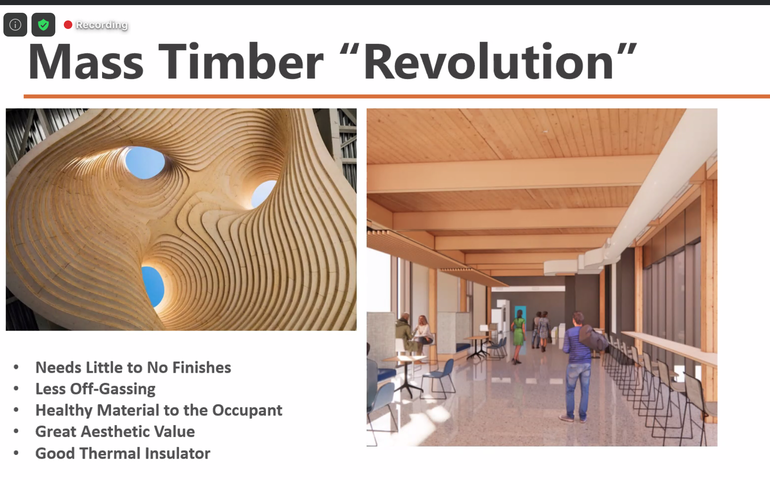
Maine may lead mass timber ‘revolution’ to reduce construction's carbon footprint
 Screenshot / Courtesy, E2Tech
Mass timber lends itself to carbon-emissions reductions and aesthetic design, SMRT Architects & Engineers President Ellen Belknap said during a recent E2Tech presentation.
Screenshot / Courtesy, E2Tech
Mass timber lends itself to carbon-emissions reductions and aesthetic design, SMRT Architects & Engineers President Ellen Belknap said during a recent E2Tech presentation.
The emergence of new timber technologies is one of the biggest advances for the construction industry as it tries to reduce the carbon footprint of buildings, according to Ellen Belknap, president of SMRT Architects & Engineers in Portland.
Belknap spoke on the topic during a recent E2Tech webinar titled "Building Smarter — Is Mass Timber a Solution?”
E2Tech is an energy, environmental, and clean technology business and economic development organization.
Belknap’s discussion centered on how to promote wood building materials such as mass timber and cross-laminated timber in Maine, and on whether producing the material in Maine made sense.
“Mass timber” means that the primary load-bearing structure of a building is a wood product.
Building a new NYC each month
Reports shows that 230 billion square meters of new construction and major renovations will be underway worldwide between now and 2060, Belknap said. That’s the equivalent of building an entire New York City every month for 40 years.

Steel and concrete are responsible for the vast majority of the construction industry’s carbon emissions, she said.
By contrast, wood materials are made from trees, which “sequester” carbon by taking it out of the atmosphere.
Until recently, the carbon conversation was dominated by “operational” carbon — emissions generated by running the electricity and heat that buildings use to keep occupants comfortable.
As energy systems and building envelopes have become more efficient and renewable energy has become more accessible, the subject of embodied carbon is gaining attention, she said.
“The next lift in the building industry is embodied carbon,” she said.
Maine has potential
Belknap said the benefits of wood include it being less energy-intensive to manufacture than steel or concrete, with less fossil fuel consumed during manufacture. It also provides extended carbon storage throughout the life of the product, she said.
Maine, which comprises nearly 90% forests, is a promising venue for advancing the use of wood, she said.
“We’re sitting in the wood basket of the Northeast,” she said.
Mass timber is emerging as an “extraordinary opportunity in design construction and climate change,” she said.
Bowdoin College is using mass timber to help with the construction of Barry Mills Hall and the Center for Arctic Studies on its campus in Brunswick.
New buildings at the Ecology School in Saco use Maine wood in the form of glue-laminated beams and I-trusses.
College of the Atlantic in Bar Harbor integrated carbon sequestration in the design of its recently completed Center for Human Ecology, through high-density wood products for exterior cladding and interior finish and insulation, including glue-laminated timbers.
Earlier this year, developers of Rock Row in Westbrook announced a 200,000-square-foot building will be constructed from cross-laminated timber.
And the University of Maine’s Advanced Structures and Composites Center in Orono is developing technology for biobased materials.
Also contributing to the mass timber push is the University of Maine-led Forest Opportunity Roadmap/Maine (FOR/Maine) Coalition, which is in the running for up to $100 million in federal funds to accelerate the northern forest bioeconomy through innovation, commercialization, workforce and community redevelopment.
New building codes
Belknap said recent advances in building codes have allowed construction of taller buildings using mass timber.
Another plus, she said, is that mass timber is easily panelized off-site, which reduces on-site labor costs.
She said the wood product is fire resistant and doesn’t need finishes, which eliminates off-gassing seen with other types of materials such as gypsum wallboards.
“It’s a healthy material to the occupants, it has great aesthetic value and it’s a good thermal insulator,” she said.
Maine’s construction industry is currently sourcing mass timber from out-of-state, which incurs a carbon impact with respect to transportation, she said.
“When we have mass timber available to us locally, it will be a game-changer,” she said.
Belknap said that her company, SMRT, which was selected to design the University of New England’s new College of Osteopathic Medicine, has planned one wing using cross-laminated timber and another wing using steel in order to accommodate larger spans.
“There’s lots of promise and lots of potential,” she said.
Major challenges to be tackled, she said, include developing mass timber production facilities in Maine and promoting education around its use as a viable product.
“I think we have miles to go but I think we’re heading in the right direction,” she said.
Mainebiz web partners
Great coverage on this important topic.













1 Comments